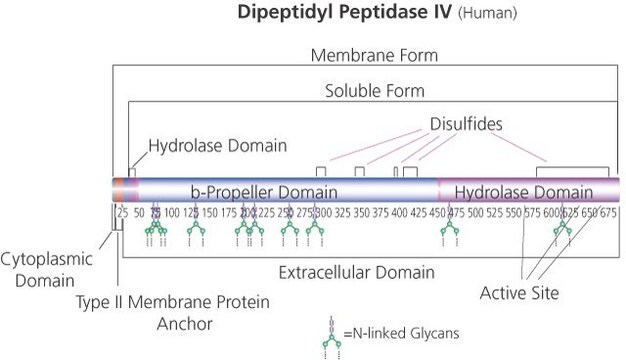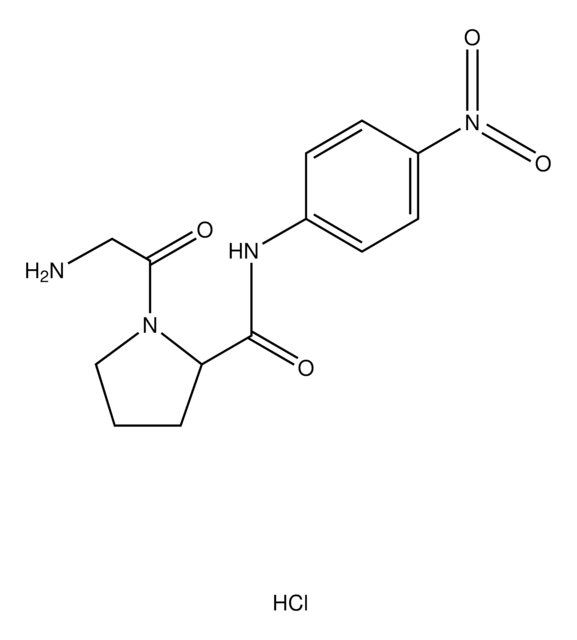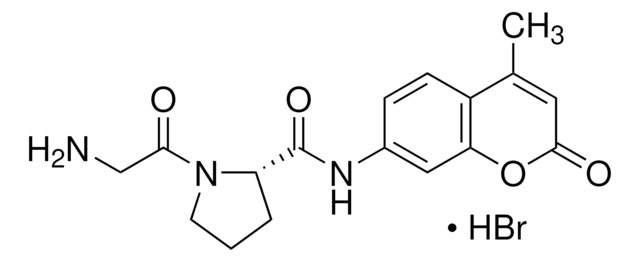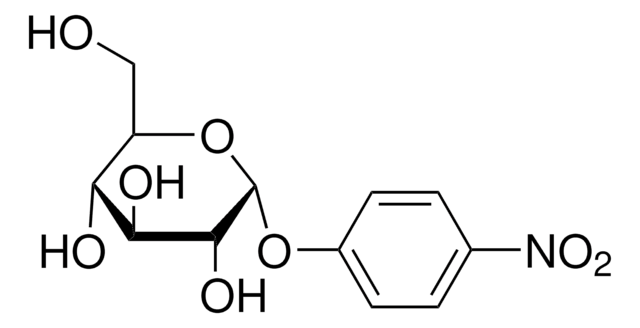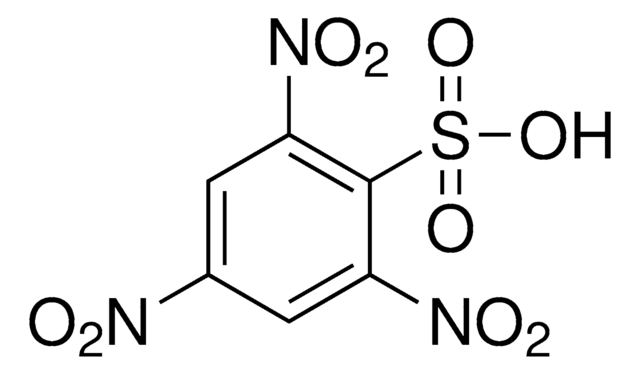317640-M
Dipeptidyl Peptidase IV (CD26), Porcine Kidney
Sinonimo/i:
CD26, DPPIV
Autenticatiper visualizzare i prezzi riservati alla tua organizzazione & contrattuali
About This Item
Prodotti consigliati
Saggio
≥90% (SDS-PAGE)
Livello qualitativo
Forma fisica
liquid
Attività specifica
≥35 units/mg protein
Produttore/marchio commerciale
Calbiochem®
Condizioni di stoccaggio
OK to freeze
avoid repeated freeze/thaw cycles
Temperatura di conservazione
−70°C
Descrizione generale
Native, DPP IV purified from porcine kidney (renal brush border of the proximal tubule). A serine exopeptidase dimer composed of two identical subunits of 110-130 kDa. Cleaves Xaa-Pro dipeptides from the N-terminus of oligo and polypeptides. DPPIV is involved in many cellular processes such as activation of cytokines, differentiation, T cell activation, and cell-matrix interactions. Inhibition of DPPIV has been reported to be an effective treatment for type II diabetes. MW: ~210000-260000 (unreduced).
Confezionamento
Please refer to vial label for lot-specific concentration.
Attenzione
Toxicity: Standard Handling (A)
Definizione di unità
One unit is defined as the amount of enzyme that will hydrolyze 1.0 µmole 7-(Gly-Pro)-amino-4-methylcoumarinamide per min at 37°C, pH 8.5.
Stato fisico
In 20 mM Tris-HCl, 5 mM CaCl₂, 1 µM ZnCl₂, 0.05% NaN₃, pH 8.0.
Ricostituzione
Dilute only the amount of enzyme needed for each assay. Upon thawing, do not re-freeze, store in the refrigerator (4°C).
Altre note
Bar, J., et al. 2003. Biol. Chem.384, 1553.
Engel, M., et al. 2003. Proc. Natl. Acad. Sci. USA100, 5063.
Ikehara, Y., et al. 1994. Methods. Enzymol.244, 215.
David, F., et al. 1993. J. Biol. Chem.268, 17247.
Thomsen, P.D., et al. 1993. Mamm. Genome4, 604.
Misumi, Y., et al. 1992. Biochim. Biophys. Acta.1131, 333.
Seidl, R., et al. 1991. Biol. Chem. Hoppe Seyler372, 213.
Checler, F., et al. 1985. J. Neurochem.45, 1509.
Imai, K., et al. 1983. J. Biochem.93, 431.
Kato, T., et al. 1979. Experientia.35, 409.
Kojima, K., et al. 1979. Anal. Biochem.100, 43.
Kato, T., et al. 1978. Biochem. Med.19, 351.
Kenny, A.J., et al. 1976. Biochem. J.157, 169.
Engel, M., et al. 2003. Proc. Natl. Acad. Sci. USA100, 5063.
Ikehara, Y., et al. 1994. Methods. Enzymol.244, 215.
David, F., et al. 1993. J. Biol. Chem.268, 17247.
Thomsen, P.D., et al. 1993. Mamm. Genome4, 604.
Misumi, Y., et al. 1992. Biochim. Biophys. Acta.1131, 333.
Seidl, R., et al. 1991. Biol. Chem. Hoppe Seyler372, 213.
Checler, F., et al. 1985. J. Neurochem.45, 1509.
Imai, K., et al. 1983. J. Biochem.93, 431.
Kato, T., et al. 1979. Experientia.35, 409.
Kojima, K., et al. 1979. Anal. Biochem.100, 43.
Kato, T., et al. 1978. Biochem. Med.19, 351.
Kenny, A.J., et al. 1976. Biochem. J.157, 169.
Note legali
CALBIOCHEM is a registered trademark of Merck KGaA, Darmstadt, Germany
Codice della classe di stoccaggio
12 - Non Combustible Liquids
Classe di pericolosità dell'acqua (WGK)
WGK 2
Punto d’infiammabilità (°F)
Not applicable
Punto d’infiammabilità (°C)
Not applicable
Certificati d'analisi (COA)
Cerca il Certificati d'analisi (COA) digitando il numero di lotto/batch corrispondente. I numeri di lotto o di batch sono stampati sull'etichetta dei prodotti dopo la parola ‘Lotto’ o ‘Batch’.
Possiedi già questo prodotto?
I documenti relativi ai prodotti acquistati recentemente sono disponibili nell’Archivio dei documenti.
Il team dei nostri ricercatori vanta grande esperienza in tutte le aree della ricerca quali Life Science, scienza dei materiali, sintesi chimica, cromatografia, discipline analitiche, ecc..
Contatta l'Assistenza Tecnica.